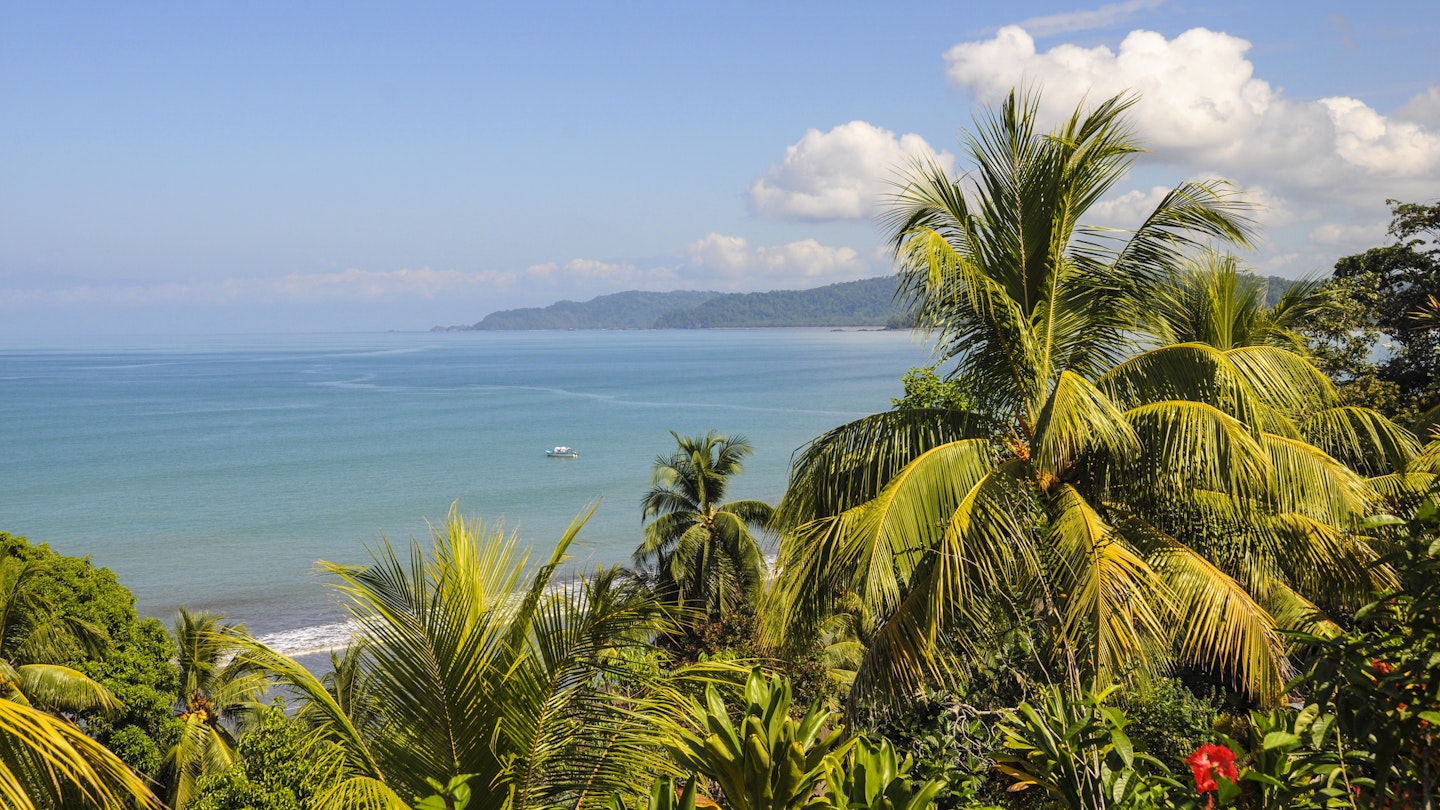Explore the Osa Peninsula, Costa Rica
Jutting into the sea at the southern end of Costa Rica’s Pacific coast, the Osa Peninsula remains one of the country’s most remote destinations.
This wild region is worth the trip: explore the vast rainforest that shelters Costa Rica’s largest remaining population of jaguars and tapirs, surf the cerulean waves along the peninsula’s southern point, and take a boat ride through its enormous expanse of mangroves.
The Osa Peninsula is also a great place to gain insight into the country’s rich past. Former gold mining villages reveal the intricacies of rural Tico life, and enormous pre-Columbian stone spheres continue to baffle archaeologists. Despite the vastly improved access road to the peninsula’s main town, other parts of Osa remain off the grid; however, the rewards for tackling the rough roads, hiking trails, and river crossings are manifold.
Corcovado National Park
Parque Nacional Corcovado, one of Costa Rica’s star attractions, takes up almost half of the Osa Peninsula. It is home to an astoundingly diverse range of wildlife, including the highly endangered giant anteater, tapir, harpy eagle, and all of Costa Rica’s big cats. Whether you access the heart of the park via a grueling day hike along one of its two main jungle trails, the coastal La Leona to Sirena or the mountainous Sirena to Los Patos, or arrive by boat to explore the shorter trails around the Sirena and San Pedrillo ranger stations, wildlife sightings are virtually guaranteed. Additionally, there’s a short trail loop from Dos Brazos that introduces visitors to the park.
You can combine a Sirena–Los Patos hike with a stay at La Tarde, an inviting property just outside the park that offers nightly tours to see snakes and frogs. Visits to Corcovado are permitted only with licensed guides, so you can organize your jungle adventure in Puerto Jiménez with various local companies that provide tours into this lush wilderness.
Drake Bay
Reachable via an exhilarating speedboat ride through the mangroves from Sierpe, by plane, or via a 4WD-only road that requires driving through rivers, Bahía Drake is a sprawling village featuring a gorgeous 10.5-mile (17km) coastal trail leading to the San Pedrillo entrance of Parque Nacional Corcovado. Drake Bay appeals to both upmarket travelers who enjoy high-end jungle lodges and backpackers, as an increasing number of budget guesthouses and tour operators facilitate visits to Corcovado, diving, kayaking in mangroves, or wildlife-spotting adventures.
Puerto Jiménez
As the closest that the Osa Peninsula gets to a bustling capital, Puerto Jiménez’s compact grid of dusty streets is the preferred launch point for budget travelers venturing to Corcovado, thanks to its proliferation of affordable accommodations and numerous tour agencies. After an adventure in the jungle, unwind on Playa Platanares, kayak on the Golfo Dulce, or indulge in some of the Osa Peninsula’s best culinary offerings at local restaurants.
Cabo Matapalo and Carate
South of Puerto Jiménez, the rough road crosses several shallow rivers en route to the beach settlement of Cabo Matapalo, the “toe” of the Osa Peninsula “boot,” where surfers in the know hit the virtually empty waves from surf-and-yoga retreats. Continuing on to Carate, which serves as the starting point for hikes in Corcovado, the road is lined with some of Costa Rica’s best all-inclusive wilderness lodges that offer gourmet cuisine and guided tours into the enveloping jungle, perfect for spotting monkeys, sloths, birds, and other wildlife.
Rural Tourism
Part of the new Caminos de Osa initiative aims to develop more hiking trails across the Osa Peninsula and boost rural tourism in local communities. The former gold mining villages of Rancho Quemado and Dos Brazos welcome visitors with a range of experiences, such as learning how cane sugar is made or indulging in wildlife watching and horseback riding. In Dos Brazos, visitors can stay at unique local accommodations or go completely off the grid at rustic farmhouses. An enlightening tour of an organic cacao farm can also provide insight into local agriculture.
Humedal Nacional Terrába-Sierpe
The back end of the Osa “boot” dissolves into a network of channels and waterways that weave around the Humedal Nacional Térraba-Sierpe, the country’s largest mangrove swamp. Its 127 sq miles (330 sq km) of wetland protects a plethora of birdlife, especially water birds such as herons, egrets, and cormorants, as well as larger denizens of the murky waters, including caimans and boas. Exploring this watery world by boat offers a unique perspective into this special and fragile ecosystem.
Isla del Caño
A 40-minute boat ride from Bahía Drake brings you to the uninhabited Isla del Caño, the centerpiece of one of Costa Rica’s most important marine reserves and a prime destination for diving and snorkeling. With its rich marine biodiversity, including coral species that provide shelter for various marine life, Isla del Caño is a must-visit for any underwater adventurer.
Sitio Arqueológico Finca 6
The exceptional museum at Sitio Arqueológico Finca 6 offers the best opportunity to view the pre-Columbian stone spheres, which are Costa Rica’s most important archaeological finds. Included on UNESCO’s list of World Heritage sites, these stones represent the monumental efforts invested by the mysterious Diquís civilization that once populated the Diquís Delta. While their exact purpose remains unclear, these spheres continue to intrigue historians and visitors alike.
This article was originally published in April 2016.





